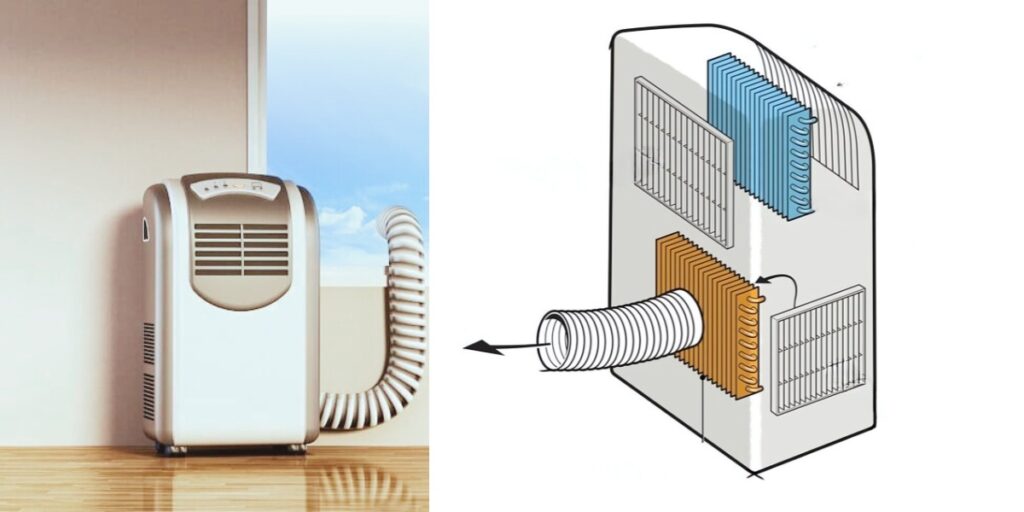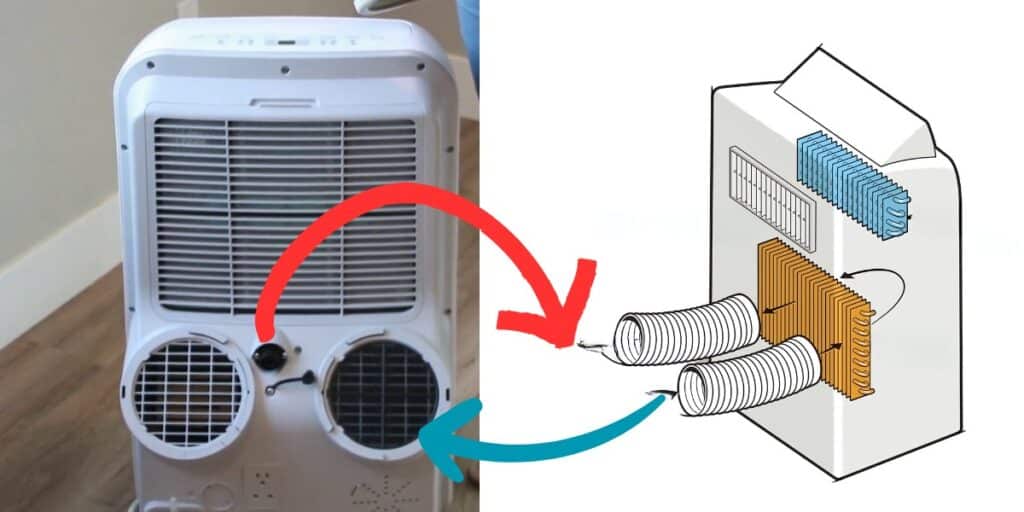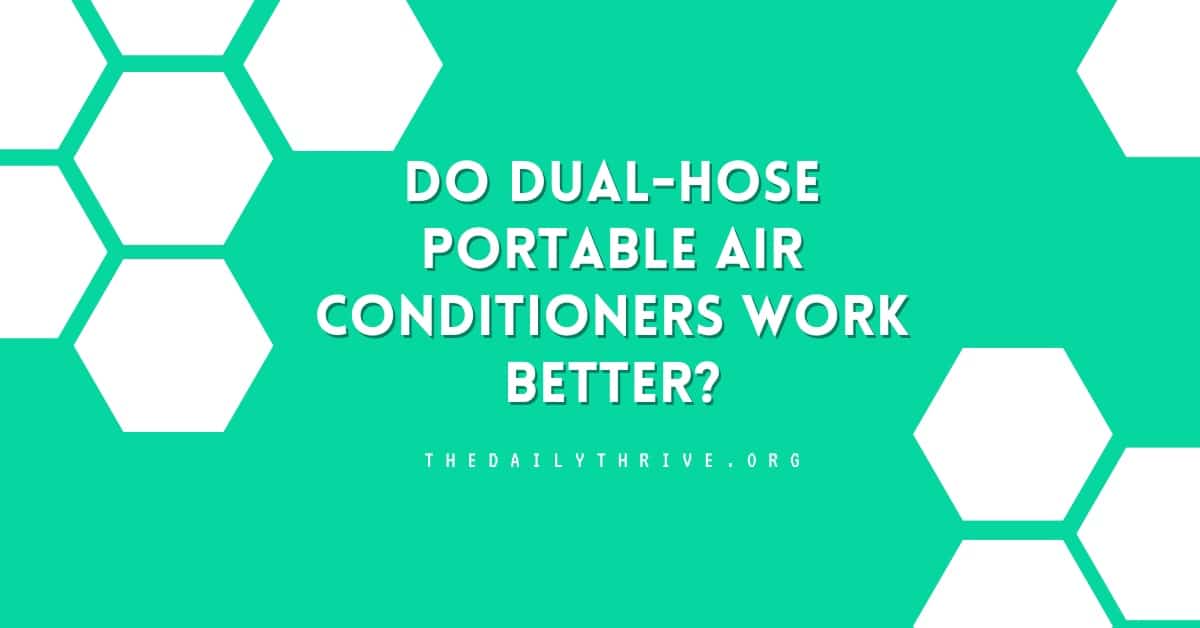Portable air conditioners are a great option for flexibility and easy installation. Among these, you might come across single-hose and dual-hose portable air conditioners. This article will help you figure out if dual-hose portable air conditioners are better by looking into their design, how they work, their pros and cons, and comparing them to single-hose units.
What is a Single-Hose Portable Air Conditioner?
A single-hose portable air conditioner operates with one hose that serves both intake and exhaust functions. The hose draws air from the room, cools it, and then expels the warm air outside. These units are typically more affordable.

Pros of Single-Hose Portable Air Conditioners
- Ease of Installation: Single-hose units are generally easier to set up because they only require one hose to be connected to a window or an exterior vent. This simplicity makes them a popular choice for many homeowners.
- Affordability: Single-hose air conditioners are usually less expensive than their dual-hose counterparts. This makes them an attractive option for those on a budget or for temporary cooling solutions.
- Portability: These units are typically lighter and more compact, making them easier to move from room to room. Their single-hose design also means fewer parts to manage during relocation.
- Energy Efficiency: While single-hose units are not the most energy-efficient option available, they can still provide adequate cooling for small to medium-sized rooms without consuming excessive power.
Cons of Single-Hose Portable Air Conditioners
- Reduced Efficiency in Larger Spaces: Single-hose units can struggle to cool larger rooms effectively. Their design limits the amount of hot air that can be expelled, which can lead to less efficient cooling in expansive areas.
- Negative Pressure: Because single-hose units expel indoor air to the outside, they can create negative pressure in the room. This can cause warm outdoor air to be drawn into the room through cracks and gaps, reducing the overall cooling efficiency.
- Limited Air Exchange: The single hose must handle both intake and exhaust functions, which can limit the volume of air exchanged and slow down the cooling process.
What is a Dual-Hose Portable Air Conditioner?
A dual-hose portable air conditioner uses two separate hoses: one for intake and one for exhaust. The intake hose draws in outdoor air to cool the unit, while the exhaust hose expels the warm air outside. This design is intended to improve cooling efficiency and performance.

Pros of Dual-Hose Portable Air Conditioners
- Increased Efficiency: By using separate hoses for intake and exhaust, dual-hose units can cool a room more quickly and efficiently. The intake hose brings in fresh air, which helps the unit operate more effectively.
- Better Performance in Larger Spaces: Dual-hose air conditioners are better suited for cooling larger rooms and spaces. Their design allows them to handle higher cooling loads and maintain consistent temperatures more effectively.
- No Negative Pressure: Unlike single-hose units, dual-hose air conditioners do not create negative pressure in the room. This prevents warm outdoor air from being drawn in, resulting in more efficient and effective cooling.
- Improved Air Quality: Dual-hose units can provide better air quality by ensuring a more consistent exchange of air. The intake hose draws in fresh air from the outside, reducing the concentration of indoor pollutants and allergens.
Cons of Dual-Hose Portable Air Conditioners
- Higher Cost: Dual-hose units are generally more expensive than single-hose models. The increased efficiency and performance come at a higher price, which may be a consideration for budget-conscious buyers.
- Complex Installation: Installing a dual-hose unit can be more complex and time-consuming. The need to connect two hoses to a window or exterior vent requires more effort and precision.
- Bulkier Design: Dual-hose air conditioners are typically larger and heavier than single-hose units. This can make them less portable and more challenging to move between rooms.
- Maintenance: With two hoses and more complex internal components, dual-hose units may require more frequent maintenance and care to ensure optimal performance.
What’s the Difference?
The primary difference between single-hose and dual-hose portable air conditioners lies in their design and how they handle air intake and exhaust. Single-hose units use one hose for both functions, while dual-hose units use separate hoses for intake and exhaust.
Cooling Efficiency: Dual-hose units are generally more efficient at cooling larger spaces because they can handle higher cooling loads and maintain consistent temperatures more effectively. Single-hose units may struggle to cool larger rooms and can be less efficient overall.
Air Quality: Dual-hose units can provide better air quality by ensuring a more consistent exchange of air. Single-hose units can create negative pressure, which may draw in warm outdoor air and reduce indoor air quality.
Installation and Portability: Single-hose units are easier to install and more portable due to their simpler design. Dual-hose units require more complex installation and are typically bulkier and heavier, making them less convenient to move.
Cost: Dual-hose units are generally more expensive than single-hose models. The increased efficiency and performance come at a higher price, which may be a consideration for budget-conscious buyers.
Key Features to Look for in a Dual Hose Portable Air Conditioner
When shopping for a portable air conditioner, there are several important features to consider. These features can enhance your experience and ensure you get the most efficient and convenient cooling for your home.
Below are some key points to keep in mind as you explore your options.
Dehumidifier Mode
One useful feature to look for in a dual hose portable AC is a dehumidifier mode. Often, the discomfort of heat is compounded by high humidity levels. An AC unit with a dehumidifier can extract excess moisture from the air, making the room feel cooler and more comfortable without necessarily lowering the temperature.
Many dual hose models allow you to run the dehumidifier independently of the air conditioning compressor. This not only helps maintain a comfortable environment but also conserves energy. High-capacity dehumidifiers can remove up to 100 pints of moisture per day.
Additionally, units with dehumidifier functions typically include self-evaporative systems, water collection tanks, or drain spouts. The self-evaporative system is preferred as it expels moisture through the exhaust hose, minimizing maintenance. Water collection tanks require periodic emptying, while drain spouts allow for continuous drainage with a connected hose.
Heat Mode
Maximizing the utility of your purchase is always a good idea and dual-hose portable air conditioners with a heat mode offer year-round functionality. These units can provide warmth during the winter months and cool air during the summer, making them versatile and cost-effective.
If you want an appliance that serves both heating and cooling purposes, ensure the model you choose includes a heat mode. This dual functionality can save space and money by eliminating the need for separate heating and cooling devices.
Sleep Mode
For those planning to use their portable air conditioner in the bedroom, a sleep mode is a valuable feature. Sleep mode adjusts the AC settings to operate at a quieter noise level, ensuring that the unit does not disturb your rest.
This mode typically fine-tunes the temperature and fan speed to create a comfortable sleeping environment, allowing you to enjoy a restful night without being woken by loud operational sounds.
Smart Wi-Fi Control
While not all dual hose portable air conditioners come with smart Wi-Fi capabilities, this feature can significantly enhance convenience. Smart controls allow you to operate the AC unit remotely via your smartphone, making it easy to turn on the cooling before you arrive home or set schedules for operation.
Some models also integrate with smart home assistants like Amazon Alexa or Google Home, enabling voice control for switching modes and adjusting settings. If remote and smart control features appeal to you, look for units with built-in Wi-Fi and compatibility with smart home systems.
Remote Control
A remote control is an essential accessory for any modern portable air conditioner. It allows you to adjust temperature settings, change modes, and control other functions from across the room. This convenience means you don’t have to get up to make changes, making the cooling experience more seamless and comfortable.
Timer
A timer function is a practical feature that lets you program the air conditioner to turn off after a certain period. This can be especially useful for conserving energy and ensuring the unit does not run unnecessarily when you are not at home or while you sleep.
With a timer, you can set the AC to operate during specific hours, helping to maintain a comfortable temperature while optimizing energy use. This feature can also provide peace of mind, knowing the unit will turn off automatically without requiring manual intervention.
Noise Level (dBA)
Considering the noise level of your dual-hose portable air conditioner is important, especially if it will be used in quiet environments like bedrooms or offices. Air conditioners have traditionally been noisy, but advancements in technology have led to quieter operations.
Dual hose units typically operate between 50-56 decibels, which is comparable to the sound of a normal conversation. Choosing a model with a lower noise level can enhance comfort, allowing you to enjoy a cool environment without disruptive noise.
The Verdict
So, do dual-hose portable air conditioners work better? The answer largely depends on your specific needs and circumstances.
If you are looking for a portable air conditioner that can efficiently cool larger spaces and maintain consistent temperatures, a dual-hose unit is likely the better choice. The improved cooling efficiency, lack of negative pressure, and better air quality make dual-hose units a superior option for more demanding cooling needs.
However, if you need a more affordable and easily portable solution for smaller spaces, a single-hose unit may be sufficient. Single-hose air conditioners offer the advantages of easier installation, lower cost, and greater portability, making them a practical choice for less intensive cooling requirements.
In conclusion, both single-hose and dual-hose portable air conditioners have their advantages and disadvantages. By understanding these differences, you can make an informed decision that ensures you stay cool and comfortable during the hottest months of the year.






